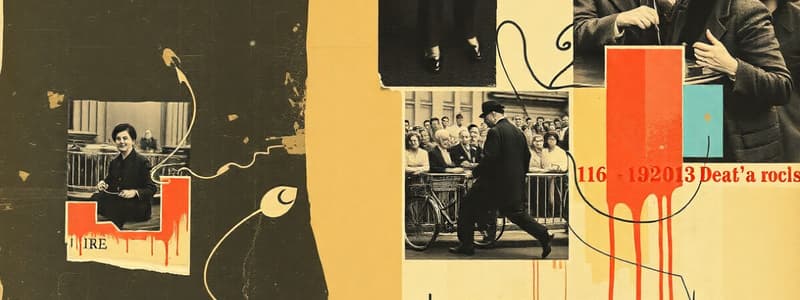Podcast
Questions and Answers
A ball is dropped from a height of 1 meter onto a hard surface. If the coefficient of restitution (COR) between the ball and the surface is 0.7, what will be the approximate height of the first bounce?
A ball is dropped from a height of 1 meter onto a hard surface. If the coefficient of restitution (COR) between the ball and the surface is 0.7, what will be the approximate height of the first bounce?
- 0.30 meters
- 0.70 meters
- 0.49 meters (correct)
- 1.00 meters
Which of the following factors has the LEAST impact on the coefficient of restitution (COR) during a bouncing collision?
Which of the following factors has the LEAST impact on the coefficient of restitution (COR) during a bouncing collision?
- The material properties of the colliding objects
- The color of the colliding objects (correct)
- The impact velocity of the colliding objects
- The temperature of the colliding objects
In a perfectly inelastic collision, what is the value of the coefficient of restitution (COR)?
In a perfectly inelastic collision, what is the value of the coefficient of restitution (COR)?
- Any value greater than 1
- 0 (correct)
- 0.5
- 1
As impact velocity increases, how does this generally affect the coefficient of restitution (COR)?
As impact velocity increases, how does this generally affect the coefficient of restitution (COR)?
Why does a bouncing ball return to a lower height with each successive bounce?
Why does a bouncing ball return to a lower height with each successive bounce?
A rubber ball and a glass ball are dropped from the same height onto a concrete floor. Which material property is MOST responsible for the rubber ball bouncing higher than the glass ball?
A rubber ball and a glass ball are dropped from the same height onto a concrete floor. Which material property is MOST responsible for the rubber ball bouncing higher than the glass ball?
How does surface texture affect the bouncing of an object?
How does surface texture affect the bouncing of an object?
In the context of bouncing, what does a coefficient of restitution (COR) of 1 represent?
In the context of bouncing, what does a coefficient of restitution (COR) of 1 represent?
In sports like basketball, what aspect of bouncing is MOST crucial for players to master for effective dribbling and ball control?
In sports like basketball, what aspect of bouncing is MOST crucial for players to master for effective dribbling and ball control?
Why is understanding the physics of bouncing important in engineering design?
Why is understanding the physics of bouncing important in engineering design?
Flashcards
Bouncing (Impact)
Bouncing (Impact)
The phenomenon where an object collides with a surface and rebounds.
Elasticity
Elasticity
A material's ability to return to its original shape after being deformed.
Coefficient of Restitution (COR)
Coefficient of Restitution (COR)
Quantifies the elasticity of a collision; ratio of final to initial relative velocity.
Energy Loss
Energy Loss
Signup and view all the flashcards
Material Properties
Material Properties
Signup and view all the flashcards
Impact Velocity
Impact Velocity
Signup and view all the flashcards
Angle of Impact
Angle of Impact
Signup and view all the flashcards
Surface Texture
Surface Texture
Signup and view all the flashcards
Temperature Effects
Temperature Effects
Signup and view all the flashcards
Bounce Height Formula
Bounce Height Formula
Signup and view all the flashcards
Study Notes
- Bouncing, also known as impact, is a complex phenomenon governed by the laws of physics, primarily involving mechanics, elasticity, and energy conservation.
- An object bounces when it collides with a surface and rebounds; the nature of the bounce depends on factors like object and surface material, object velocity, and impact angle.
Elasticity and Coefficient of Restitution
- Elasticity is a key property determining how well an object bounces, describing a material's ability to return to its original shape after deformation.
- Perfectly elastic collisions, where kinetic energy is conserved, are theoretical ideals; in reality, some energy is always lost, typically converted into heat or sound due to internal friction and deformation.
- The coefficient of restitution (COR), denoted 'e', quantifies the elasticity of a collision and is defined as the ratio of the final relative velocity to the initial relative velocity between two objects after they collide.
- COR values range from 0 to 1, where 1 represents a perfectly elastic collision (no energy loss) and 0 represents a perfectly inelastic collision (maximum energy loss, objects stick together).
- The formula for COR: e = (relative velocity after collision) / (relative velocity before collision).
- For a ball bouncing off a stationary surface, COR simplifies to: e = (velocity of ball after impact) / (velocity of ball before impact).
- COR is affected by factors like material properties, temperature, and impact velocity of the colliding objects.
Energy Loss During Bouncing
- Energy loss during bouncing results from deformation of the object and surface (energy required to change the shape), internal friction within the materials (generating heat), sound production (creating sound waves), and vibrations (consuming energy).
- Each bounce returns to a lower height due to energy loss, which affects the height and duration of subsequent bounces.
Factors Affecting Bouncing
- Material Properties
- The elasticity of both the bouncing object and the surface significantly impacts the bounce; highly elastic materials bounce better.
- Hardness affects deformation during impact; harder materials tend to deform less, conserving more energy.
- Impact Velocity
- Higher impact velocities can lead to greater deformation and energy loss.
- The relationship between impact velocity and COR is not always linear; COR may decrease with increasing velocity.
- Angle of Impact
- At an angle, the bounce involves both vertical and horizontal components of velocity.
- The angle of incidence (incoming angle) and angle of reflection (outgoing angle) are related, but energy loss can affect the reflection angle.
- Surface Texture
- Rough surfaces can increase friction and energy dissipation during impact, reducing the bounce.
- Smooth surfaces tend to provide more consistent and predictable bounces.
- Temperature
- Temperature can influence the elasticity of materials; for many materials, higher temperatures decrease elasticity.
Mathematical Description
- The height of a bounce can be related to the initial drop height using the COR: h2 = e^2 * h1 (where h1 is the initial height and h2 is the height of the first bounce).
- This relationship extends for multiple bounces: hn = e^(2n) * h1, where hn is the height of the nth bounce.
- The time between bounces decreases with each successive bounce due to decreasing height.
- If the bounce occurs at an angle, projectile motion principles apply, and equations of motion can describe the trajectory, considering initial velocity, angle, and gravitational acceleration.
Practical Applications
- Sports: Understanding bouncing is critical in sports like basketball, tennis, and golf, impacting equipment design and player techniques.
- Engineering: Bouncing principles are used in designing impact-resistant materials, packaging, and vehicle safety systems.
- Material Science: Studying bouncing behavior helps characterize material properties and develop new materials with specific elasticity.
- Robotics: Robots use bouncing for locomotion and interacting with environments.
- Computer Simulations: Realistic bouncing is crucial in creating realistic physics simulations for games and engineering analysis.
Studying That Suits You
Use AI to generate personalized quizzes and flashcards to suit your learning preferences.




